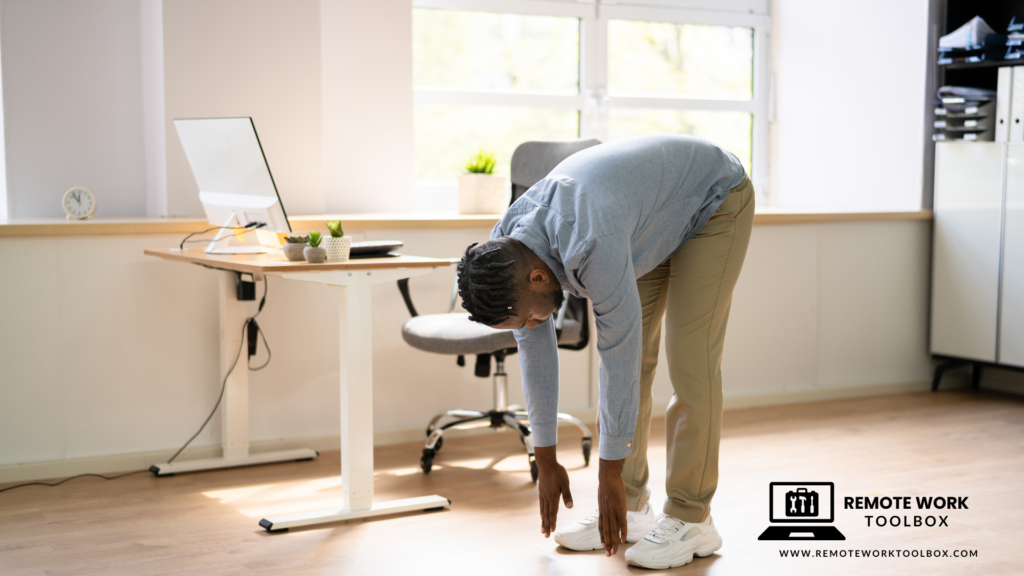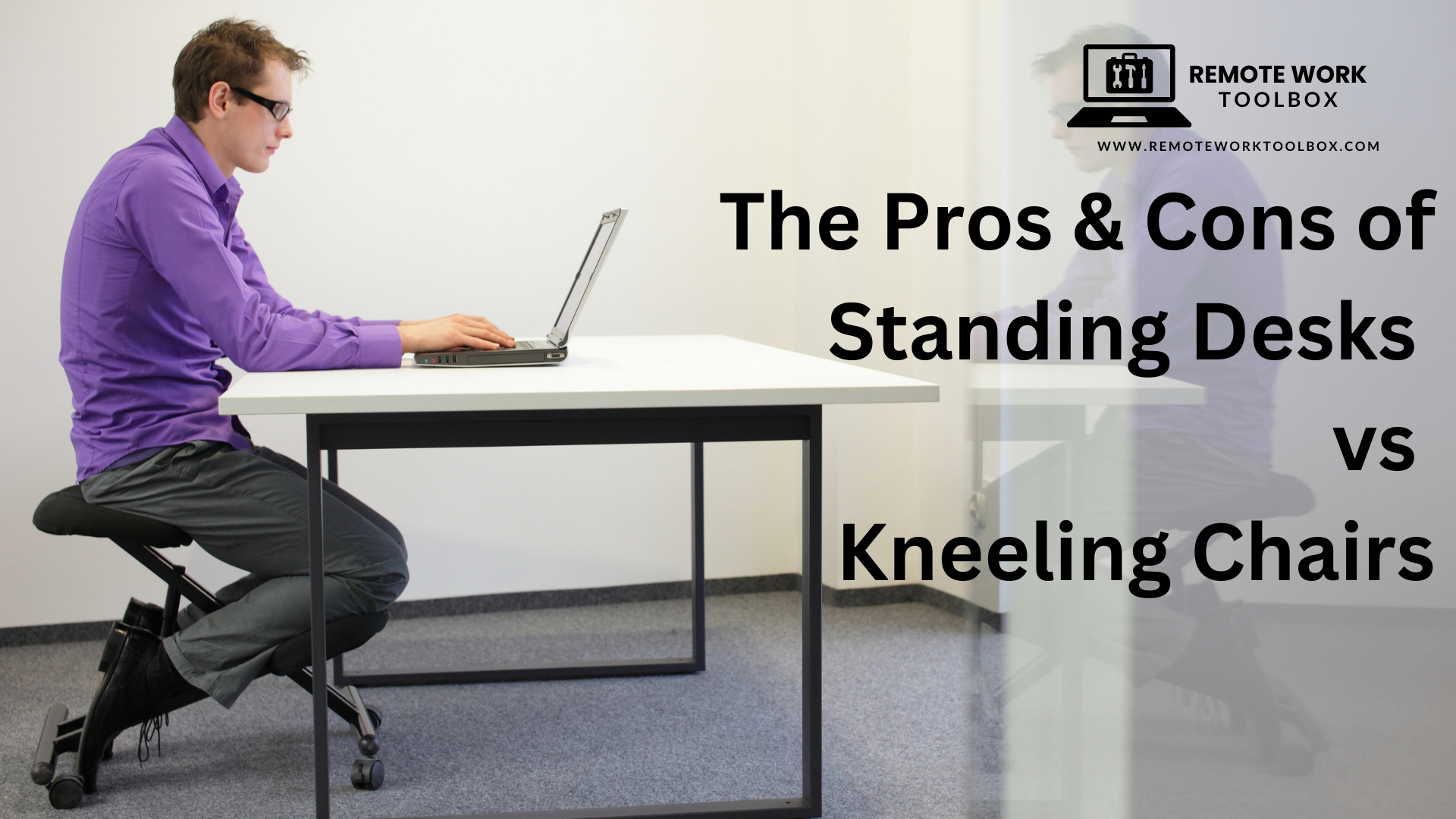Staying active while working from home is crucial for maintaining both physical and mental health. A sedentary lifestyle, which often accompanies remote work, can lead to various health issues such as heart disease, weight gain, and decreased cognitive function. This article aims to provide 14 desk exercises that are easy to perform and can help you stay active, fit, and healthy while working from home. By incorporating these exercises into your daily routine, you can enhance your physical activity levels and overall well-being.
Benefits of Desk Exercises
Desk exercises offer numerous benefits, including:
- Improved Physical Health: Regular exercise helps reduce the risk of heart disease, weight gain, and other chronic conditions associated with a sedentary lifestyle. Engaging in physical activity can strengthen muscles, improve cardiovascular fitness, and promote better overall health.
- Enhanced Mental Health: Physical activity boosts mental health by reducing stress, anxiety, and depression levels. It also enhances cognitive function, helping you stay focused and productive during long periods of work.
- Better Work-Life Balance: Incorporating exercise into your workday can help balance work and personal life, providing a structured break from work tasks and promoting a healthy work-life balance.
- Increased Productivity: Regular movement breaks can enhance focus, productivity, and energy levels. Short breaks for physical activity can reduce fatigue and help you return to work with renewed concentration.
- Overall Health: Engaging in physical activity is vital for maintaining good health and preventing a sedentary lifestyle. It can boost energy levels, improve mood, and contribute to a healthier, more active lifestyle.
Assessing Your Home Office Setup
Before starting your desk exercise routine, it’s essential to ensure your home office setup is conducive to physical activity:
- Desk Chair: Use a comfortable and supportive desk chair that allows for a range of motion. An ergonomic chair can help maintain good posture and prevent back pain.
- Ergonomic Setup: Arrange your workspace ergonomically to prevent strain and injury. Ensure your computer screen is at eye level, and your desk and chair are at the correct height to support proper posture.
- Standing Desk: Consider using a standing desk or balance ball chair to encourage movement. Alternating between sitting and standing can reduce the risks associated with prolonged sitting.
- Space for Exercise: Create a designated space in your home office or living room for exercise. Ensure you have enough space to perform stretches, strength training, and other exercises comfortably.
14 Desk Exercises to Stay Active While Working from Home
1. Seated Leg Lifts
How to Perform:
- Sit upright in your chair with feet flat on the floor.
- Extend one leg straight out and hold for a few seconds.
- Lower it back to the floor and repeat with the other leg.
Benefits:
- Strengthens lower body muscles.
- Improves blood flow and reduces the risk of leg cramps.
Additional Tips:
- Perform 3 sets of 10-15 repetitions for each leg.
- Engage your core muscles to maintain stability and balance.
2. Chair Squats
How to Perform:
- Stand in front of your desk chair with feet shoulder-width apart.
- Lower yourself into a squat, hovering just above the chair.
- Stand back up and repeat.
Benefits:
- Engages core and lower body muscles.
- Improves balance and stability.
Additional Tips:
- Keep your back straight and knees aligned with your toes.
- Perform 3 sets of 12-15 repetitions.
3. Seated Marches
How to Perform:
- Sit upright in your chair with feet flat on the floor.
- Lift one knee towards your chest and lower it back down.
- Repeat with the other knee, alternating sides.
Benefits:
- Increases heart rate and cardiovascular fitness.
- Strengthens hip flexors and improves mobility.
Additional Tips:
- Maintain a steady rhythm and controlled movements.
- Perform 3 sets of 20-30 seconds of marching.
4. Desk Push-Ups
How to Perform:
- Stand facing your desk and place your hands on the edge, shoulder-width apart.
- Step back to form a straight line from head to heels.
- Lower your chest towards the desk and push back up.
Benefits:
- Strengthens upper body and core muscles.
- Can be done using a desk or a sturdy table.
Additional Tips:
- Keep your body in a straight line throughout the exercise.
- Perform 3 sets of 10-12 push-ups.
5. Calf Raises
How to Perform:
- Stand behind your chair and hold the backrest for support.
- Rise onto your toes and hold for a few seconds.
- Lower your heels back to the floor and repeat.
Benefits:
- Strengthens lower legs and improves circulation.
- Easy to perform during breaks or while standing.
Additional Tips:
- Perform 3 sets of 15-20 repetitions.
- Focus on slow and controlled movements.
6. Desk Stretches
How to Perform:
- Sit or stand with your back straight.
- Raise your arms overhead and stretch upwards.
- Gently lean to the left and right, stretching your sides.
Benefits:
- Relieves tension in the neck and shoulders.
- Improves posture and flexibility.
Additional Tips:
- Hold each stretch for 15-30 seconds.
- Incorporate deep breathing to enhance relaxation.
7. Seated Torso Twists
How to Perform:
- Sit upright with feet flat on the floor.
- Place your hands behind your head.
- Twist your torso to the left and hold for a few seconds.
- Return to center and twist to the right.
Benefits:
- Engages core muscles and improves flexibility.
- Helps reduce back pain from prolonged sitting.
Additional Tips:
- Perform 3 sets of 10-12 twists per side.
- Keep your movements slow and controlled.
8. Arm Circles
How to Perform:
- Sit or stand with your arms extended to the sides.
- Make small circles with your arms, gradually increasing the size.
- Reverse the direction after a set.
Benefits:
- Increases blood flow and warms up shoulder muscles.
- Can be done while seated or standing.
Additional Tips:
- Perform 3 sets of 20-30 seconds of arm circles in each direction.
- Focus on maintaining good posture throughout the exercise.
9. Wrist and Finger Stretches
How to Perform:
- Extend your arm in front of you with palm facing down.
- Use the other hand to gently pull back on your fingers.
- Hold for a few seconds and switch sides.
Benefits:
- Prevents repetitive strain injuries.
- Improves hand flexibility and reduces tension.
Additional Tips:
- Perform 2-3 sets of 15-20 seconds of stretches for each wrist.
- Incorporate these stretches into your routine to prevent wrist and finger discomfort.
10. Standing Desk Exercises
How to Perform:
- Use a standing desk to perform simple exercises like calf raises, leg lifts, and stretches.
- Alternate between sitting and standing throughout the day.
Benefits:
- Reduces the risk of a sedentary lifestyle.
- Encourages regular movement and improves posture.
Additional Tips:
- Perform standing exercises for 5-10 minutes every hour.
- Use a balance board for added stability and core engagement.
11. Seated Forward Bends
How to Perform:
- Sit at the edge of your chair with feet flat on the floor.
- Bend forward from the hips, reaching towards your feet.
- Hold for a few seconds and slowly return to the starting position.
Benefits:
- Stretches lower back and hamstrings.
- Relieves tension from prolonged sitting.
Additional Tips:
- Perform 2-3 sets of 15-20 seconds of stretches.
- Focus on maintaining a straight back during the stretch.
12. Ankle Rotations
How to Perform:
- Sit upright with feet flat on the floor.
- Lift one foot and rotate the ankle in circles.
- Switch directions and repeat with the other ankle.
Benefits:
- Improves joint mobility and reduces stiffness.
- Can be done discreetly during meetings.
Additional Tips:
- Perform 3 sets of 20-30 seconds of rotations for each ankle.
- Focus on controlled and steady movements.
13. Desk Tricep Dips
How to Perform:
- Sit on the edge of your desk or a sturdy chair.
- Place your hands on the edge, fingers pointing forward.
- Slide off the edge and lower your body by bending your elbows.
- Push back up and repeat.
Benefits:
- Strengthens upper arms and shoulders.
- Can be done using a desk or a stable chair.
Additional Tips:
- Perform 3 sets of 10-12 tricep dips.
- Keep your movements slow and controlled to avoid injury.
14. Desk Yoga Poses
How to Perform:
- Practice simple yoga poses like seated forward bends, neck stretches, and shoulder rolls.
- Focus on deep breathing and holding each pose for a few seconds.
Benefits:
- Reduces stress and enhances mental clarity.
- Improves flexibility and relaxation.
Additional Tips:
- Incorporate 2-3 yoga poses into your daily routine.
- Use a yoga mat for added comfort and support.
Tips for Incorporating Desk Exercises into Your Routine
- Set Reminders: Use alarms or reminders to take regular movement breaks. Regular reminders can help you stay consistent with your exercise routine.
- Pomodoro Technique: Use this technique to schedule exercise breaks every 25-30 minutes. The Pomodoro technique encourages productivity by incorporating regular breaks for physical activity.
- Incorporate Exercises into Daily Routines: Perform exercises during phone calls, video conferences, or while waiting for a file to upload. This ensures you stay active throughout the day without taking time away from work.
- Create a Workout Routine: Develop a personalized workout routine that fits your schedule and fitness levels. Tailor your routine to include a mix of strength training, flexibility exercises, and cardiovascular activities.
- Use Available Resources: Utilize online fitness classes, apps, or videos for guided exercises. These resources can provide structured workout plans and ensure you perform exercises correctly.
- Stay Consistent: Make desk exercises a regular part of your daily routine. Consistency is key to reaping the long-term benefits of physical activity.
- Track Your Progress: Keep a log of your exercises and progress. Tracking your achievements can motivate you to stay committed to your fitness goals.
- Mix It Up: Vary your exercises to target different muscle groups and keep your routine interesting. Incorporating different types of exercises can prevent boredom and promote balanced fitness.
- Encourage Colleagues: Share your desk exercise routine with colleagues and encourage them to join you. Creating a supportive environment can enhance motivation and accountability.
- Stay Hydrated: Drink plenty of water throughout the day to stay hydrated, especially during and after exercise.
- Take Breaks Outdoors: If possible, take short breaks outdoors for fresh air and a brisk walk. This can boost your mood and energy levels.
Recap of Desk Exercises
- Seated Leg Lifts: Strengthens lower body muscles and improves blood flow.
- Chair Squats: Engages core and lower body muscles, improving balance and stability.
- Seated Marches: Increases heart rate and cardiovascular fitness, strengthening hip flexors.
- Desk Push-Ups: Strengthens upper body and core muscles.
- Calf Raises: Strengthens lower legs and improves circulation.
- Desk Stretches: Relieves tension in the neck and shoulders, improving posture.
- Seated Torso Twists: Engages core muscles and improves flexibility, reducing back pain.
- Arm Circles: Increases blood flow and warms up shoulder muscles.
- Wrist and Finger Stretches: Prevents repetitive strain injuries and improves hand flexibility.
- Standing Desk Exercises: Reduces the risk of a sedentary lifestyle and encourages regular movement.
- Seated Forward Bends: Stretches lower back and hamstrings, relieving tension from prolonged sitting.
- Ankle Rotations: Improves joint mobility and reduces stiffness.
- Desk Tricep Dips: Strengthens upper arms and shoulders.
- Desk Yoga Poses: Reduces stress, enhances mental clarity, and improves flexibility.
Personalize Your Routine
- Identify Your Needs: Tailor your exercise routine to address your specific health and fitness goals.
- Set Realistic Goals: Set achievable fitness goals and track your progress over time.
- Listen to Your Body: Pay attention to your body’s signals and adjust your exercises as needed to prevent injury.
- Seek Professional Advice: Consult with a personal trainer or healthcare professional if you have any concerns or specific health conditions.
Staying active while working from home is essential for maintaining overall health and well-being. By incorporating these 14 desk exercises into your daily routine, you can improve your physical health, reduce stress, and boost productivity. Remember to take regular breaks, maintain good posture, and stay committed to an active lifestyle. Implementing these exercises can have a positive impact on your energy levels, cognitive function, and overall health.
Regular physical activity is crucial for combating the negative effects of a sedentary lifestyle. By integrating desk exercises into your workday, you can ensure that you remain active, healthy, and productive. Whether you are taking a quick movement break between tasks or dedicating time to a full-body workout, these exercises will help you stay fit and energized while working from home.
By following this detailed guide and incorporating desk exercises into your daily routine, you can stay active, healthy, and productive while working from home. Regular exercise will help you maintain good physical and mental health, ensuring that you can perform at your best both at work and in your personal life.




![Hybrid Remote Work From Home Policy + Template [2024]](https://remoteworktoolbox.com/wp-content/uploads/2024/06/Hybrid-Remote-Work-From-Home-Policy-Template-2024.png)